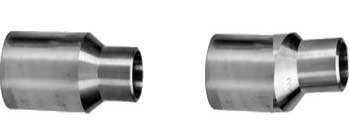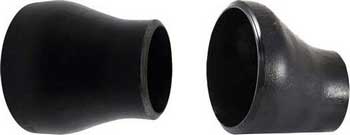Swage nipples vs Butt Weld Reducers
Swage nipples and Butt Weld reducers are often a topic of much debate. Which of these components are best suited in a piping system, and therefore it is important to understand their differences.
Function and types of Swage nipples

Concentric Swage nipples: These reduce evenly in diameter, keeping the centerlines of both ends aligned. They are ideal for applications that require smooth and continuous flow.
Eccentric Swage nipples: These have an uneven reduction, with the centerline of the smaller end shifting relative to the larger end. They are used to prevent problems such as air pockets or uneven flow by maintaining specific pipe alignments.
Function and types of BW Reducers

BW reducers are another type of pipe fitting, of which two main types are available.
These are the concentric and eccentric reducers, which have the same functions as Swage nipples.
Differences Between Swage nipples & BW reducers
Both Swage nipples and BW reducers serve to connect pipes of different sizes, but there are some important differences.
1. Size Ranges
The size range of the reducer is wide. The current size standard of the BW reducer ranges from NPS1/2 to over NPS 100, while the specification of the Swage nipple ranges from NPS 1/4 to NPS 12.
2. Base Materials
Seamless steel tubes or steel plates are used as base material for BW reduces, while round bar steel or billet steel is used as base material for swage nipples.
3. Production Processes
The manufacturing process of BW reducers is of heat pressing or cold pressing, for the seamless BW reducers, and the hot rolling process is applied for other BW reducers. The manufacturing process of Swage nipple is the forging process.
Materials
Swage nipples
In terms of raw materials, Swage nipples are made from round bar steel or billet steel, ideal for high-pressure applications.
Some examples of material standards, but many more specifications are available.
- ASTM A105: Standard specification for carbon steel forgings for piping applications
- ASTM A350: Standard specification for carbon and low-alloy steel forgings requiring notch toughness testing for piping components
- ASTM A182: Standard specification for forged or rolled alloy and stainless steel pipe flanges, forged fittings, and valves
BW reducers
BW reducers, on the other hand, use seamless pipe or steel plates, making them versatile for different applications.
Some examples of material standards, but many more specifications are available.
- ASTM A234: Standard specification for piping fittings of wrought carbon steel and alloy steel for moderate and high-temperature service
- ASTM A403: Standard specification for wrought austenitic stainless steel piping fittings
Connection ends & Dimensions
Beveled ends are mainly used for BW reducers, while straight ends are only used for relatively thin wall thicknesses.
Swage nipples have more types of connection ends and can be divided into beveled, straight and threaded ends.
read more at..
swage Nipples Ends
Swage Nipples Size Chart acc. to MSS-SP-95
Butt Weld Fitting.. Reducer
Dimensions BW Reducers acc. to ASME B16.9
Applications and benefits
Both Swage nipples and BW reducers are essential in various industries because of their critical role in piping systems.
Swage nipples: are precise and reliable, making them ideal for high-pressure applications such as drilling and well completion in the oil and gas industry. Their advantages are versatility, strength, durability and leak-free performance.
BW reducers: are widely used for general reducers and are valued for their wide range of applications and ease of installation. They are often used in industries such as petrochemical, construction and plumbing systems.
The choice between Swage nipples and vBW reducers depends on the specific requirements of an application and ensures the best fit in the piping system.
Remark(s) of the Author...

In this article, I use the term BW (Butt Weld) reducer. These reducers are provided with beveled ends on both sides to make a Butt Weld. This BW is a circumferential butt welded joint, and the most common type of joint employed in the fabrication of welded pipe systems.
These reducers can also be fabricated with plain ends, and welded with a so-called fillet weld. However, this is not an industry standard, and the weld will be considerably weaker.
Threaded ends for BW reducers are not available by default.

From Swage nipples I have only known for a few years, that diameters up to 12 inches are available, while I have been working in piping systems for ages.
Dimensions up to 2inch were known to me in the various versions, and have seen them used regularly, but especially in Small Bore pipe systems.
In Socket Weld, Butt Weld and Threaded pipe systems Swage nipples are particularly useful, and are easy to apply in a Small Bore pipe system.
Larger diameters from Swage nipples I have never seen (or haven't noticed) and therefore I can't tell anything about them